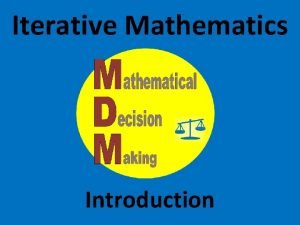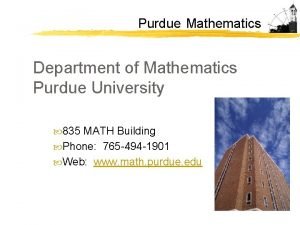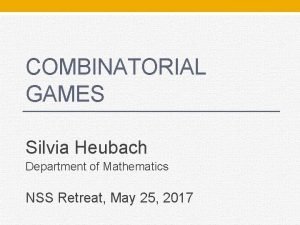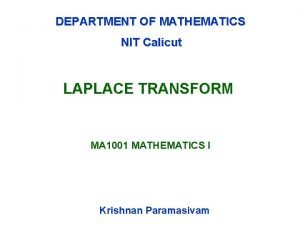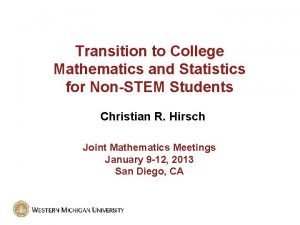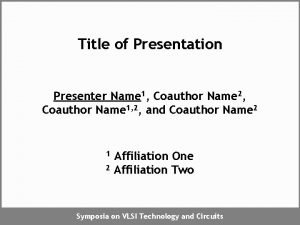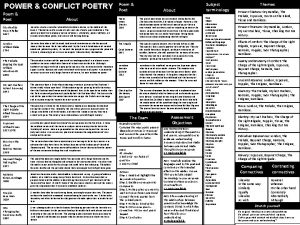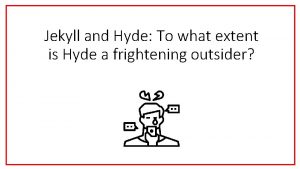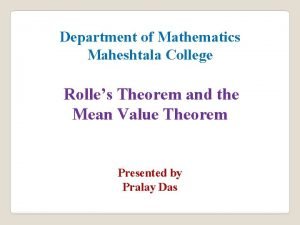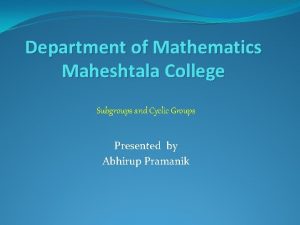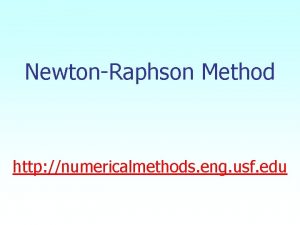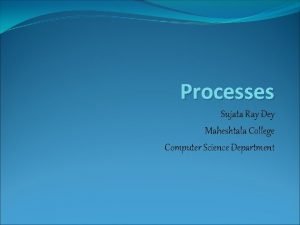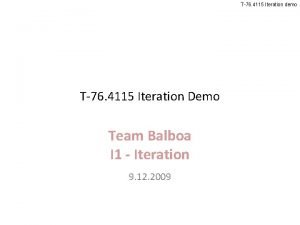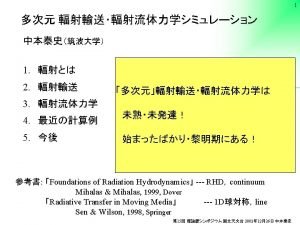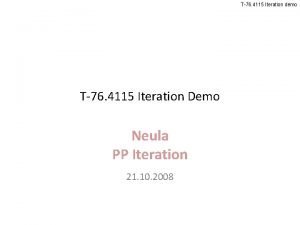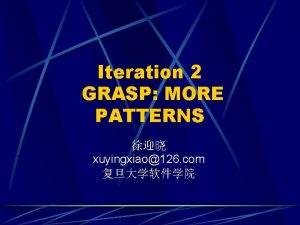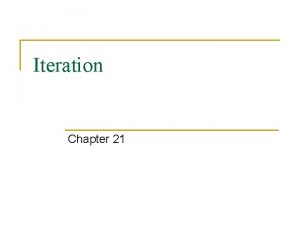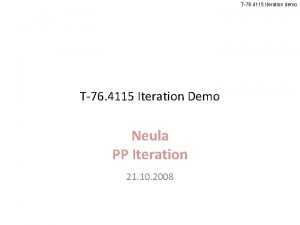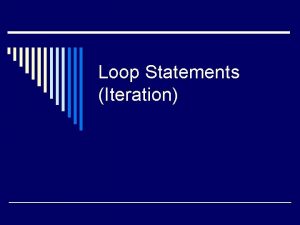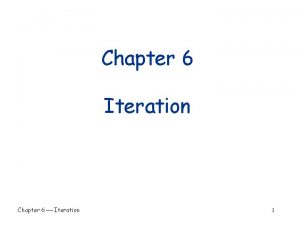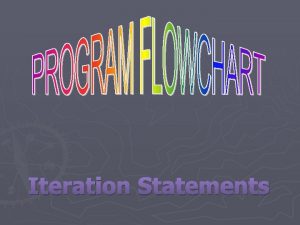Department of Mathematics Maheshtala college NewtonRaphson Iteration Presented





















- Slides: 21

Department of Mathematics Maheshtala college Newton-Raphson Iteration Presented by Ajijur Rahaman Mallick

Newton-Raphson Iteration It isn’t always possible to find iterative formulae of the type that will find the solution of every equation. Another iterative method that is useful is called the Newton-Raphson method.

Newton-Raphson Iteration Suppose we want to find an approximate solution to the equation To see how the method works, we’ll sketch using. The root lies between 1 and 2. We’ll zoom in near

Newton-Raphson Iteration Suppose our first estimate is given by. We draw the tangent to the curve at The point where the tangent meets the x-axis we call. Repeating. . . Each point , , . . . is closer to.

Newton-Raphson Iteration To carry out the iteration we need to find the points where the tangents meet the x-axis. x The grad. of the tangent

Newton-Raphson Iteration We have Using and we need to find and in the formula isn’t very convenient, so, since we have and Then, Rearranging: .

Newton-Raphson Iteration So, We just need to alter the subscripts to find : Generalising gives We don’t need a diagram to use this formula but we must know how to differentiate. Convergence is often very fast.

Newton-Raphson Iteration e. g. Use the Newton-Raphson method with to find the root of the equation correct to 4 d. p. Solution: Let Differentiate: Using a calculator we need: Then,

Newton-Raphson Iteration SUMMARY To use the Newton-Raphson method to estimate a root of an equation: Ø rearrange the equation into the form Ø differentiate Ø substitute to find and into the formula Ø choose a suitable starting value for Ø use a calculator to iterate Tip: It saves a lot of errors if, before you type the formula into your calculator, you write the formula with ANS replacing every x.

Exercise Newton-Raphson Iteration 1. (a) Use the Newton-Raphson method to estimate the root of the following equation to 6 d. p. using the starting value given: (b) What happens if you use ? (c) Use your calculator or a graph plotter to sketch the graph of. (d) What is special about the graph at and why does it explain the answer to (b) ? 2. Use the Newton-Raphson method to estimate one root of to 4 d. p. using

Newton-Raphson Iteration (a) Solution: Let

Newton-Raphson Iteration (b) What happens if you use (c) ? The iteration fails immediately. At x = 0, there is a stationary point. At a stationary point so in the formula we are dividing by 0. We also notice that the tangent never meets the x-axis.

Newton-Raphson Iteration 2. Use the Newton-Raphson method to estimate one root of to 4 d. p. using Solution: Let Radians!

Newton-Raphson Iteration The Newton-Raphson method will fail if Ø i. e. at a stationary point It will also sometimes fail to give the expected root if the initial value is close to a stationary point. Can you draw a graph to show what could happen in this case? This is one example.

Newton-Raphson Iteration With the iteration gives the root instead of the closer root .

Newton-Raphson Iteration

Newton-Raphson Iteration The following slides contain repeats of information on earlier slides, shown without colour, so that they can be printed and photocopied. For most purposes the slides can be printed as “Handouts” with up to 6 slides per sheet.

Newton-Raphson Iteration It isn’t always possible to find iterative formulae of the type that will find the solution of every equation. Another iterative method that is useful is called the Newton-Raphson method.

Newton-Raphson Iteration SUMMARY To use the Newton-Raphson method to estimate a root of an equation: Ø rearrange the equation into the form Ø differentiate Ø substitute to find and into the formula Ø choose a suitable starting value for Ø use a calculator to iterate Tip: It saves a lot of errors if, before you type the formula into your calculator, you write the formula with ANS replacing every x.

Newton-Raphson Iteration e. g. Use the Newton-Raphson method with to find the root of the equation correct to 4 d. p. Solution: Let Differentiate: Using a calculator we need: Then,

Newton-Raphson Iteration The Newton-Raphson method will fail if Ø i. e. at a stationary point It will also sometimes fail if the initial value is close to a stationary point.
 Iterative rule for sequence
Iterative rule for sequence Office of academics and transformation
Office of academics and transformation Math.purdue.edu ma261
Math.purdue.edu ma261 Department of mathematics
Department of mathematics Nit calicut mathematics department
Nit calicut mathematics department Transition to college mathematics and statistics pdf
Transition to college mathematics and statistics pdf Rowan college of science and mathematics
Rowan college of science and mathematics Pasadena city college police department
Pasadena city college police department Flushleft
Flushleft Presentation by name
Presentation by name Setting in jekyll and hyde
Setting in jekyll and hyde Hatred theme examples
Hatred theme examples Identify a key term used in both passages.
Identify a key term used in both passages. Name/title of presenter
Name/title of presenter How is power presented in ozymandias
How is power presented in ozymandias Jerome bruner cognitive theory
Jerome bruner cognitive theory Hyde as an outsider
Hyde as an outsider Talisman presented
Talisman presented Topic, main idea supporting details
Topic, main idea supporting details Kamikaze and prelude comparison
Kamikaze and prelude comparison Technological design process
Technological design process Bob cratchit quotes
Bob cratchit quotes
